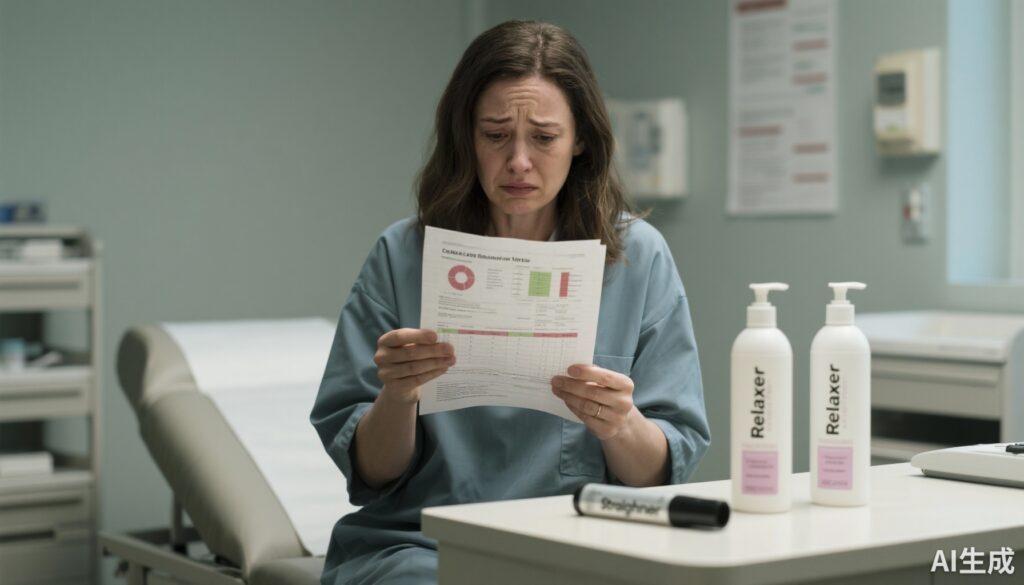Highlights
– In a prospective analysis of 46,287 participants from the Sister Study (median follow‑up 13.1 years), use of hair straighteners/chemical relaxers in the prior 12 months was associated with higher incidence of thyroid cancer (HR 1.71, 95% CI 1.01–2.89) and pancreatic cancer (HR 2.66, 95% CI 1.25–5.66).
– Non‑Hodgkin lymphoma (NHL) incidence was elevated (HR 1.62), but confidence intervals were wide and included the null (95% CI 0.94–2.80).
– No clear dose–response relation with frequency of product use was observed; associations for other non‑reproductive cancers (melanoma, lung, leukemia, colorectal, kidney) were negligible or imprecise.
Background
Hair straighteners and chemical relaxers are widely used cosmetic products. Chemical relaxers typically include strong alkali formulations (lye or no‑lye hydroxides) or other reactive chemistries, while some straightening treatments (eg, keratin treatments) may involve formaldehyde or formaldehyde‑releasing agents. Exposure is topical, but scalp application and inhalation during salon procedures can result in systemic absorption of multiple ingredients. Prior epidemiologic work has linked some hair product exposures to reproductive cancers in certain populations, and laboratory data indicate that some ingredients used in hairstyling products can be genotoxic or endocrine‑active in vitro. Despite this biologic plausibility, the relationship between hair straighteners/chemical relaxers and incidence of non‑reproductive cancers had not been well characterized prior to the study under review.
Study design
The analysis used data from the Sister Study, a U.S. nationwide prospective cohort of women enrolled 2003–2009 who had a sister with breast cancer but were themselves cancer‑free at baseline. The analytic sample comprised 46,287 women aged 35–74 years at enrollment. Participants reported frequency of hair straightener/chemical relaxer use during the 12 months preceding study entry (exposure assessed by questionnaire). Incident non‑reproductive cancers evaluated included melanoma, thyroid, lung, non‑Hodgkin lymphoma (NHL), leukemia, pancreatic, colorectal, and kidney cancers; cancers were self‑reported and confirmed by pathology reports when available.
Statistical analysis employed multivariable Cox proportional hazards models to estimate hazard ratios (HRs) and 95% confidence intervals (CIs) for associations between any recent use of hair straighteners/chemical relaxers and incident cancers. Models adjusted for age, race and ethnicity, educational attainment, and smoking status. Median follow‑up was 13.1 years, allowing capture of a substantial number of incident events for some outcomes.
Key findings
During follow‑up the study identified the following notable associations:
- Thyroid cancer: 225 cases; HR 1.71 (95% CI 1.01–2.89) associated with any recent use of hair straighteners/chemical relaxers. This indicates a 71% higher incidence among recent users compared with non‑users, with confidence intervals that exclude the null at the conventional 0.05 level but are wide.
- Pancreatic cancer: 138 cases; HR 2.66 (95% CI 1.25–5.66) for any recent use. This point estimate is large and the CI excludes the null, but the absolute number of cases is modest and CIs are wide, reflecting uncertainty.
- Non‑Hodgkin lymphoma: 313 cases; HR 1.62 (95% CI 0.94–2.80). The point estimate suggests a possible increased incidence but the CI crosses unity, making the finding imprecise and not conventionally statistically significant.
For the remaining cancer sites examined—melanoma, lung, leukemia, colorectal, and kidney—estimates were either close to null or imprecise with wide confidence intervals, providing little evidence of association in this cohort.
Importantly, the authors report little evidence of a dose–response relationship with increasing frequency of product use in the prior year. Dose–response is a key component of causal inference; its absence weakens the case for causality, although misclassification of exposure (eg, single timepoint assessment) could obscure a true gradient.
Interpretation and clinical relevance
The findings raise potential concern that use of hair straighteners and chemical relaxers may be associated with elevated incidence of certain non‑reproductive cancers—most notably thyroid and pancreatic cancers in this analysis—and possibly NHL. From a clinical standpoint, these associations are hypothesis‑generating rather than definitive. The elevated HRs for thyroid and pancreatic cancer merit attention because they were statistically significant in this cohort, but wide CIs and a lack of dose–response indicate uncertainty about effect size and causality.
Absolute risk considerations are important: even a twofold relative increase in a rare cancer may translate into a small absolute increase in risk. For example, pancreatic cancer incidence in the general population is relatively low compared with cancers such as breast or lung, so the population‑level impact depends on baseline incidence and prevalence of use in different demographic groups.
Biological plausibility and potential mechanisms
Several pathways could plausibly link hair product exposures to systemic carcinogenesis. Ingredients used in some straightening formulations or salon procedures (eg, formaldehyde or formaldehyde‑releasers during certain keratin treatments, strong alkali agents, or aromatic organic compounds) have been associated with irritation, DNA‑reactive properties in some assays, or endocrine activity in laboratory studies. Repeated topical application to the scalp—an area with a high vascular supply—and inhalation exposure during salon treatments can facilitate systemic absorption. Inflammatory or immunomodulatory effects could conceivably contribute to lymphoid malignancies, while genotoxic or endocrine‑disrupting activities could influence epithelial cancers in organs such as the thyroid or pancreas. Importantly, mechanistic data specific to contemporary commercial relaxer and straightener formulations remain limited, and ingredient composition varies by product and time period.
Strengths and limitations
Strengths
- Prospective cohort design with long median follow‑up (13.1 years) reduces recall bias for outcome ascertainment and allows temporal ordering of exposure preceding outcome.
- Large overall sample size from a well‑characterized cohort with validated outcome ascertainment when pathology reports were available.
- Adjustment for major confounders (age, race/ethnicity, education, smoking) in time‑to‑event models.
Limitations
- Exposure measurement relied on a single self‑reported assessment of product use in the 12 months before enrollment. This snapshot may misclassify long‑term or lifetime use patterns, product types, application techniques, and exposures at younger ages when cumulative risk might differ.
- No ingredient‑level data were available, so the analysis cannot ascribe risk to specific chemicals or formulations.
- Potential residual confounding remains a concern (for example, by other lifestyle, occupational, or environmental exposures correlated with hair product use).
- The Sister Study cohort enrolled women who had a sister with breast cancer; although participants were cancer‑free at baseline, this design could affect generalizability to broader populations.
- Case counts for some endpoints—particularly pancreatic cancer—were modest, producing imprecise estimates and wide confidence intervals.
- Absence of dose–response and reliance on recent rather than cumulative exposure data limits causal inference.
Implications for clinicians and public health
Clinicians should interpret these findings as preliminary evidence that warrants further investigation rather than a trigger for immediate broad clinical warnings. When counseling patients, clinicians can acknowledge the study’s observations, emphasize the current uncertainty, and place relative risks in the context of absolute risk and personal values. For patients with concerns about chemical exposures from hair products, practical risk‑mitigation strategies include minimizing scalp exposure, improving ventilation during salon procedures, limiting frequency of chemical treatments, and choosing products with simpler ingredient lists when feasible.
Recommendations for future research
Key priorities to clarify the observed associations include:
- Prospective studies with repeated, longitudinal exposure assessment capturing lifetime use, age at first use, product formulation, and frequency/duration of application.
- Ingredient‑level exposure assessment and biomonitoring (eg, urinary or blood biomarkers for suspect compounds) to link specific chemicals to outcomes.
- Mechanistic studies to assess genotoxicity, endocrine effects, and systemic absorption of modern formulations.
- Analyses in diverse populations with attention to racial and socioeconomic patterns of product use, because use of relaxers and certain straighteners is more prevalent in some groups.
- Pooled analyses or meta‑analyses that increase statistical power for rare cancer endpoints such as pancreatic cancer.
Conclusion
This large prospective analysis from the Sister Study reports associations between recent use of hair straighteners/chemical relaxers and higher incidence of thyroid cancer and pancreatic cancer, with a possible association for non‑Hodgkin lymphoma. The findings are hypothesis‑generating and biologically plausible in light of known properties of some hair product ingredients, but limitations—including exposure misclassification, lack of ingredient‑level data, modest case counts for certain cancers, and absence of dose–response—temper causal interpretation. Confirmation in independent cohorts, improved exposure assessment, and mechanistic data are needed before definitive practice changes or regulatory actions can be recommended.
Funding and clinical trial registration
Funding and acknowledgments are reported in the original publication (Bailey et al., J Natl Cancer Inst. 2025). This analysis used observational cohort data and is not a registered interventional trial.
Selected reference
Bailey JT, Chang CJ, Gaston SA, Jackson CL, Sandler DP, O’Brien KM, White AJ. Use of hair straighteners and chemical relaxers and incidence of non‑reproductive cancers. J Natl Cancer Inst. 2025 Sep 30:djaf280. doi: 10.1093/jnci/djaf280. Epub ahead of print. PMID: 41022397; PMCID: PMC12487841.
International Agency for Research on Cancer (IARC). IARC Monographs on the Evaluation of Carcinogenic Risks to Humans. Some aromatic amines and related compounds, and personal use of hair colorants and hairdressing. IARC Monographs. 2010 (selected background reading on hair product exposures and cancer classification).
Thumbnail prompt
A realistic, medium‑shot image of a concerned middle‑aged woman in a clinical consultation room holding a one‑page summary of study results; on the table beside her are unlabeled bottles resembling hair straightener/relaxer products and a stylist’s cape; neutral clinical lighting, subdued color palette, photographic style.



